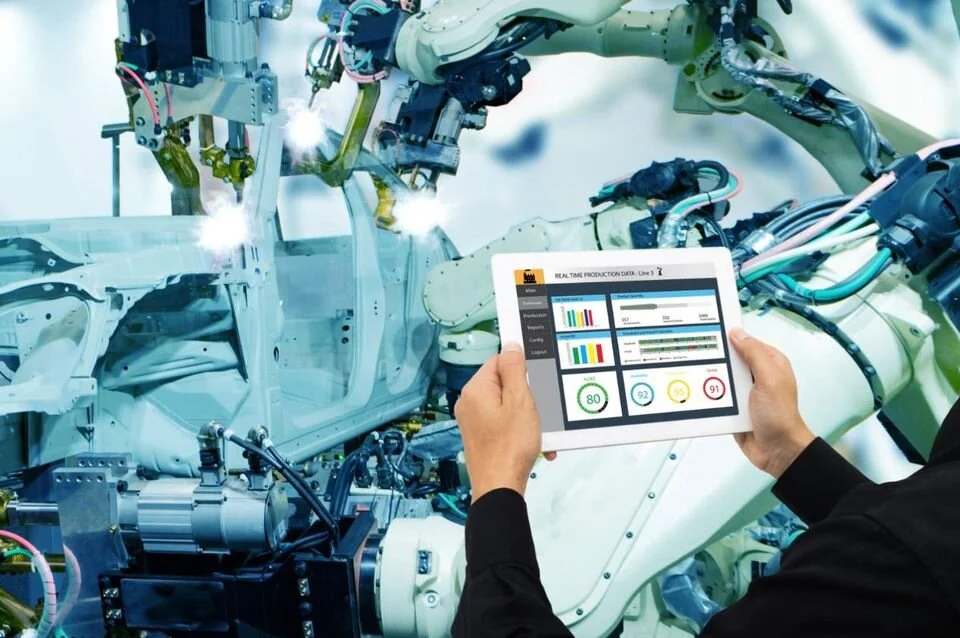
Small & Large Players
Robotics and automation tools are now foundational parts of warehouses and manufacturing facilities around the world. Unlike much other robotics and AI use cases, the technology has moved well beyond the theoretical into practice and is used by small suppliers and large companies like Amazon and Walmart. There’s still plenty of market left to transform every step of the supply chain and lots of room for players looking to adapt by redefining different verticals. Naturally, VCs are plenty eager to invest millions in technology.

B2B2C
Providing enhanced customer experiences has not typically been the primary focus of most manufacturers. Instead, most of the consumer-oriented efforts were left to retail and channel partners. But in today’s hyper-competitive market, customer-centricity has become just as important in the business-to-business (B2B) environment. With recent technology advancements, manufacturers now have an opportunity to not only capture more customer data but to analyze it in a way to better position their business for success. Companies are participating in this process otherwise known as the shift from B2B to B2B2C.

Partnerships
According to Deloitte's 2020 Manufacturing Outlook report, manufacturers are turning to partnerships for digital momentum. As manufacturers think about building agility into their supply chains, there is an increasing realization that these efforts cannot occur in isolation. The need to cultivate a strong ecosystem is a trend that has emerged. Research shows that it is an increasingly effective strategy for manufacturers, especially as it relates to digital momentum. Manufacturers are investing in this trend and believe the payout in the coming year is twofold.

Complex Supply Network
While this digital transformation of the $10-trillion-plus global manufacturing sector will play out over a decade or more, pioneers are moving to drive bottom-line and top-line impact in the near term. The aerospace-and-defense industry is using digital tools to integrate an enormously complex supply network. A modern jet turbine engine has hundreds of individual parts, for example, some of which the engine manufacturer makes in-house and others it sources from a network of dozens of vendors. The complexity of sourcing can multiply quickly. Cloud computing-based tools allow suppliers to collaborate faster and more efficiently. Companies are utilizing information sharing and transparency in the supply chain to reduce required labor, reduce risk, and increase the speed of operations.

Coronavirus Supply Chain Impact
Apple became one of the first companies to reveal how the coronavirus was affecting its business, saying it was cutting its sales expectations for Q1. The novel coronavirus outbreak in China is affecting nearly every sector of tech manufacturing, leading analysts to reduce production estimates for everything from TVs and smartphones to laptops and video game consoles. As a result, companies are exploring ways to secure the supply chain and mitigate risks in order to protect operations and consumers. The outbreak is forcing companies to factor the cost of failure into their calculation and preemptively develop mitigation plans.

Renewable Energy Sources
Transitioning to renewable energy sources, manufacturers are demonstrating success in doing well by doing good by generating new revenue streams through socially or environmentally conscious products and/or services. These initiatives, more often than not, contribute to profitability. The commitment toward green and clean energy continues in 2020 as numerous manufacturers are experimenting with multiple renewable energy resources for current and future energy procurement, including solar, wind, hydro, and geothermal.

Mass Customization
New technologies are helping the manufacturing industry transition and adapt to the have-it-your-way economy. Personalized manufacturing strategies are bringing customization to a massive new scale. The market is begging for a return of craftsmanship.
Slowly, but surely, a design-it-yourself business model has grown in the manufacturing industry. Companies are increasingly practicing lean customization by running heavily on high tech and less on operation. With the combination of lean customization, just-in-time inventory, and digital technologies, companies can do customized manufacturing simply and efficiently.

Supply Chain Performance
While it is true that consumers are accustomed to acceleration and convenience, suppliers are starting to feel the pressure to satisfy insatiable consumers by delivering a variety of goods in smaller sizes at a faster pace.
Supply chains are adapting the instant gratification economy and simplifying operations. perform more efficiently. The next generation of technology in touch and voice user interfaces and their proliferation via consumer devices produces a better integration of machines in warehouse processes and operations.

Downtime
The cost of machine maintenance and functionality can be extremely costly to the business. According to WSJ, unplanned downtime costs the industrial manufacturing sector approximately $50 billion annually. Of that downtime, 42% is a direct result of equipment failure. Unplanned downtime or outages produce excessive maintenance, repair, and replacements.
The downtime has a ripple effect that, unrelated to costs, also can hurt tangible and intangible operations resulting in lost revenue opportunities and can damage the brand. Technology like predictive analytics enables manufacturers to mitigate the risk of downtime by understanding and determining the probability of machinery breakdown. This insight is revealed before planning the maintenance window, avoiding costly unplanned downtime.

Cybersecurity
Manufacturers are increasingly under threat from cyberattacks. Today’s interconnected world invites vulnerability to company supply chains and business models. Successful infiltration for cybercriminals could shut down operations altogether or hurt standard operations.
Most manufacturing firms that are small businesses have yet to implement mature security applications or IT services. While it may not be in the budget, its important that all manufacturing firms take proper precautions by familiarizing themselves with threats or risks in order to protect the company.

Augmented Reality and the Smart Factory
The fourth industrial revolution is spreading across the manufacturing industry landscape. A growing number of suppliers are implementing augmented reality into their day to day operations to make tasks more efficient.
These applications have proven to bridge the digital reality gap. A growing number of manufacturers, including large automated equipment manufacturers, are utilizing the technology to provide both their employees and customers with virtual, hands-on instruction for operating machinery, troubleshooting and conducting repairs. Incorporating AR into industrial processes is proven to boost productivity among workers and enable companies to sustain consistent growth.

SMEs
The vast majority of manufacturing firms in the United States are quite small. At their core, manufacturing businesses create products with raw materials or components made either with the help of machines or made by hand. Most commonly, these goods are made in plants, factories, and mills, but products can also be made in people’s homes.
Small business manufacturers have agile business models and are often nimble enough with the profit margins that they can afford to produce custom or specialty products that larger manufacturers cannot. Manufacturing is essential to many industries and has a massive impact on the U.S. economy. Small business manufacturers are tweaking their operations to make operations more efficient with the help of technological advancements.

Jobs, Jobs, Jobs
Half a million factory jobs in the U.S. are unfilled and the unemployment rate is rearing a 50 year low. What does this mean for the manufacturing industry? Competition for skilled workers has increased dramatically as manufacturers pull out all of the stops to fill their positions and improve their productivity.
Companies are combating the challenging landscape by ramping up their incentive packages to further entice workers who may be hesitant to relocate. Manufacturers are raising their wages, offering bonuses and covering relocation costs, this is inclusive to some hourly positions. To add to the fire, Americans are now moving around the country at the lowest rate in 70 years. The war on talent continues as organizations become increasingly creative in their efforts to attract and retain talent.

Manufacturing at Risk for Disruption
The manufacturing industry continues to be at risk for disruption. While 2019 showed overall industry prosperity and growth for the global manufacturing sector, the sector slowed in anticipation and preparation for forecasted downturns in global manufacturing increases.
Surface level constraints identified by the industry include job placements, tight labor markets, tariff uncertainty, trade flows, etc. According to Delloite’s 2020 Manufacturing Industry Outlook survey results, 67.9% of manufacturers have an optimistic outlook on business. The remaining 32.1% of participants revealed a negative outlook; a prevailing sentiment for the industry’s future.

IoT Innovation
Disruptive technology does not invade one industry at a time, it is everywhere. The manufacturing industry presents innumerable opportunities for IoT technology to alleviate certain pain points. This is seen in certain industry sectors such as healthcare, retail, consumer goods, martech, etc.
IoT applications overlapping in industry operations have revealed insightful avenues to improve efficiency across the board including new data and improved connectivity. IoT has proven to offer valuable insight on behalf of the industry regarding costs, productivity, and processes.

Predictive Data
Predictive data continues to serve as the stronghold for informing business strategy, consumer experience, and innovation. Any and all downtime can truly hurt production in a standard manufacturing environment. In order to alleviate operations and workflow, predictive analyses have revealed transformational industry opportunities.
While the current landscape is full of risk and uncertainty, analytics to inform execution is a sure thing. Data, AI, and analytics can help operations by analyzing machine productivity, why some work and why some fail and further prevent these mishaps from occurring. While the future of the industry may not have predictive analytics on deck, making a proactive and efficient business model is a good way to equip company supply chains for the unknown.

Digital Muscles
Customer relationships are extremely valuable to just about every industry out there. For manufacturing, customer satisfaction builds brand loyalty which generally results in repeat business. With the consumer in mind, thee experience is constantly evolving to eliminate all pain points making each transaction as seamless as possible.
The deployment of digital technology gives manufacturers the upper hand and will aftermarket services. Bringing service operations up to speed has been number one on company priority lists to adapt to the landscape and forecast demand.

















